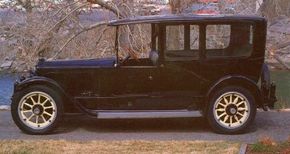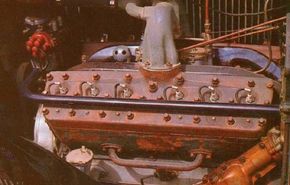Packard built its early success as the standard American luxury car with the four-cylinder Thirty of 1907-1912 and the mighty Six of 1912-1915. But the model that really cemented Packard's reputation as a make of the highest rank was the 1916-1923 Packard Twin Six, which one-upped Cadillac's 1915 V-8 with four more cylinders and lasted with relatively few changes for eight years: a remarkably long run.
Advertisement
In three series between 1916 and 1923, Packard built slightly more than 35,000 Twins, including numerous chassis for custom bodies. The Twin Six was the chief reason why, when the wealthy ordered a custom-bodied car, they tended to choose a Packard chassis.
Jesse Vincent, Packard's chief engineer, liked the 12-cylinder layout for three reasons: performance, smoothness, and silence. "A six-cylinder motor is theoretically in absolutely perfect balance," he wrote. "This is because the vibratory forces due to the rise and fall of one piston are neutralized by equal and opposite forces due to another...Now it is only possible to cancel out forces in this way if they are tied together strongly."
This meant a heavy crankcase and crankshaft and a rigid flywheel. But a Twelve or "Twin Six," Vincent continued, would provide the same rigidity and smoothness with less piston, crankcase, flywheel, and crankshaft weight -- and provide more horsepower and torque, to boot. He preferred a V-12 to a V-8 because a V-8 would require a wider frame, larger turning radius, and more complicated steering gear.
The Twin Six engine duly embodied the above principles, with two banks of L-head cylinders set at a 60-degree angle (versus 90 degrees in Cadillac's V-8). This allowed accessories to be bolted just below the frame, where they were protected from road hazards, while keeping the valves accessible.
Delivering 85 horsepower at 3,000 rpm, a bore and stroke at 3.00 × 5.00 inches resulted in a displacement of 424 cubic inches. Rockers were eliminated, with a separate cam for each valve, and all valves were located inboard of the cylinder blocks. A short, light crankshaft ran in three main bearings.
Vincent proclaimed that torque was "50 percent better than it would have been with a V-8, and 100 percent better than the Packard Six. Six impulses per crankshaft revolution blend together so closely as to make it absolutely impossible to distinguish any pause between impulses, even at very low engine speeds...The only thing I can liken it to is the action of steam."
For more on the 1916-1917 Packard Twin Six, continue to the next page.
For more information on cars, see:
- Classic Cars
- Muscle Cars
- Sports Cars
- Consumer Guide New Car Search
- Consumer Guide Used Car Search
Advertisement



